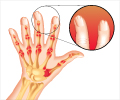Scientists were able to measure hyaluronic acid (HA) molecule indicative of osteoarthritis using nanotechnology.

‘Nanotechnology helps detect hyaluronic acid (HA), a specific molecule indicative of osteoarthritis and a number of inflammatory diseases.’





"Our results established a new, quantitative method for the assessment of a significant molecular biomarker that bridges a gap in the conventional technology," said lead author Adam R. Hall, Ph.D., assistant professor of biomedical engineering at Wake Forest School of Medicine, part of Wake Forest Baptist. "The sensitivity, speed and small sample requirements of this approach make it attractive as the basis for a powerful analytic tool with distinct advantages over current assessment technologies."
The most widely used method is gel electrophoresis, which is slow, messy, semi-quantitative, and requires a lot of starting material, Hall said. Other technologies include mass spectrometry and size-exclusion chromatography, which are expensive and limited in range, and multi-angle light scattering, which is non-quantitative and has limited precision.
The study, which is published in the current issue of Nature Communications, was led by Hall and Elaheh Rahbar, Ph.D., of Wake Forest Baptist, and conducted in collaboration with scientists at Cornell University and the University of Oklahoma.
In the study, Hall, Rahbar and their team first employed synthetic HA polymers to validate the measurement approach. They then used the platform to determine the size distribution of as little as 10 nanograms (one-billionth of a gram) of HA extracted from the synovial fluid of a horse model of osteoarthritis.
Advertisement
"By using a minimally invasive procedure to extract a tiny amount of fluid - in this case synovial fluid from the knee - we may be able to identify the disease or determine how far it has progressed, which is valuable information for doctors in determining appropriate treatments," he said.
Advertisement
Source-Eurekalert















